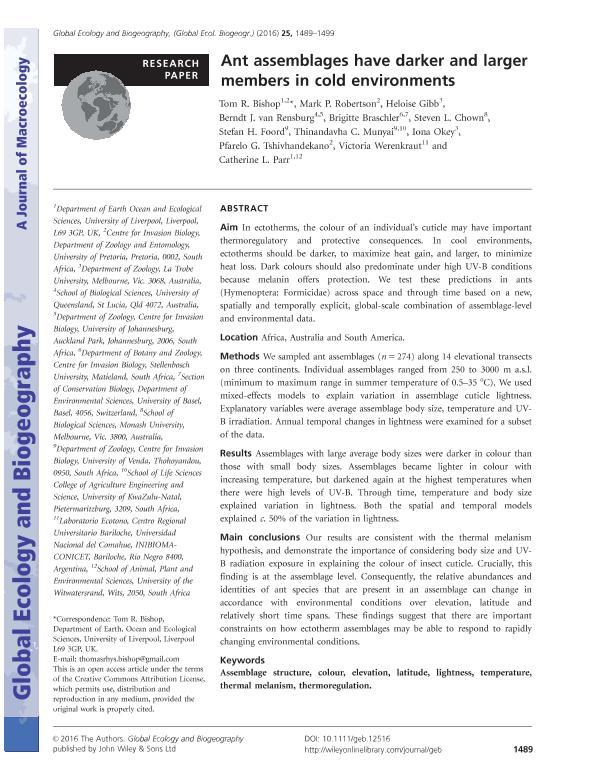Mostrar el registro sencillo del ítem
dc.contributor.author
Bishop, Tom R.
dc.contributor.author
Robertson, Mark P.
dc.contributor.author
Gibb, Heloise
dc.contributor.author
van Rensburg, Berndt J.
dc.contributor.author
Braschler, Brigitte
dc.contributor.author
Chown, Steven L.
dc.contributor.author
Foord, Stefan H.
dc.contributor.author
Munyai, Thinandavha C.
dc.contributor.author
Okey, Iona
dc.contributor.author
Tshivhandekano, Pfarelo G.
dc.contributor.author
Werenkraut, Victoria

dc.contributor.author
Parr, Catherine L.
dc.date.available
2019-02-07T16:03:21Z
dc.date.issued
2016-12
dc.identifier.citation
Bishop, Tom R.; Robertson, Mark P.; Gibb, Heloise; van Rensburg, Berndt J.; Braschler, Brigitte; et al.; Ant assemblages have darker and larger members in cold environments; Wiley Blackwell Publishing, Inc; Global Ecology and Biogeography; 25; 12; 12-2016; 1489-1499
dc.identifier.issn
1466-822X
dc.identifier.uri
http://hdl.handle.net/11336/69632
dc.description.abstract
Aim: In ectotherms, the colour of an individual's cuticle may have important thermoregulatory and protective consequences. In cool environments, ectotherms should be darker, to maximize heat gain, and larger, to minimize heat loss. Dark colours should also predominate under high UV-B conditions because melanin offers protection. We test these predictions in ants (Hymenoptera: Formicidae) across space and through time based on a new, spatially and temporally explicit, global-scale combination of assemblage-level and environmental data. Location: Africa, Australia and South America. Methods: We sampled ant assemblages (n = 274) along 14 elevational transects on three continents. Individual assemblages ranged from 250 to 3000 m a.s.l. (minimum to maximum range in summer temperature of 0.5–35 °C). We used mixed-effects models to explain variation in assemblage cuticle lightness. Explanatory variables were average assemblage body size, temperature and UV-B irradiation. Annual temporal changes in lightness were examined for a subset of the data. Results: Assemblages with large average body sizes were darker in colour than those with small body sizes. Assemblages became lighter in colour with increasing temperature, but darkened again at the highest temperatures when there were high levels of UV-B. Through time, temperature and body size explained variation in lightness. Both the spatial and temporal models explained c. 50% of the variation in lightness. Main conclusions: Our results are consistent with the thermal melanism hypothesis, and demonstrate the importance of considering body size and UV-B radiation exposure in explaining the colour of insect cuticle. Crucially, this finding is at the assemblage level. Consequently, the relative abundances and identities of ant species that are present in an assemblage can change in accordance with environmental conditions over elevation, latitude and relatively short time spans. These findings suggest that there are important constraints on how ectotherm assemblages may be able to respond to rapidly changing environmental conditions.
dc.format
application/pdf
dc.language.iso
eng
dc.publisher
Wiley Blackwell Publishing, Inc

dc.rights
info:eu-repo/semantics/openAccess
dc.rights.uri
https://creativecommons.org/licenses/by/2.5/ar/
dc.subject
Assemblage Structure
dc.subject
Colour
dc.subject
Elevation
dc.subject
Latitude
dc.subject
Lightness
dc.subject
Temperature
dc.subject
Thermal Melanism
dc.subject
Thermoregulation
dc.subject.classification
Otras Ciencias Biológicas

dc.subject.classification
Ciencias Biológicas

dc.subject.classification
CIENCIAS NATURALES Y EXACTAS

dc.title
Ant assemblages have darker and larger members in cold environments
dc.type
info:eu-repo/semantics/article
dc.type
info:ar-repo/semantics/artículo
dc.type
info:eu-repo/semantics/publishedVersion
dc.date.updated
2019-01-23T18:58:08Z
dc.journal.volume
25
dc.journal.number
12
dc.journal.pagination
1489-1499
dc.journal.pais
Reino Unido

dc.journal.ciudad
Londres
dc.description.fil
Fil: Bishop, Tom R.. University of Pretoria; Sudáfrica. University of Liverpool; Reino Unido
dc.description.fil
Fil: Robertson, Mark P.. University of Pretoria; Sudáfrica
dc.description.fil
Fil: Gibb, Heloise. La Trobe University; Australia
dc.description.fil
Fil: van Rensburg, Berndt J.. Queensland University of Technology; Australia
dc.description.fil
Fil: Braschler, Brigitte. Stellenbosch University; Sudáfrica. Universidad de Basilea; Suiza
dc.description.fil
Fil: Chown, Steven L.. Monash University; Australia
dc.description.fil
Fil: Foord, Stefan H.. University of Venda; Australia
dc.description.fil
Fil: Munyai, Thinandavha C.. University of Venda; Australia. University of KwaZulu‐Natal; Sudáfrica
dc.description.fil
Fil: Okey, Iona. La Trobe University; Australia
dc.description.fil
Fil: Tshivhandekano, Pfarelo G.. University of Pretoria; Sudáfrica
dc.description.fil
Fil: Werenkraut, Victoria. Consejo Nacional de Investigaciones Científicas y Técnicas. Centro Científico Tecnológico Conicet - Patagonia Norte. Instituto de Investigaciones en Biodiversidad y Medioambiente. Universidad Nacional del Comahue. Centro Regional Universidad Bariloche. Instituto de Investigaciones en Biodiversidad y Medioambiente; Argentina. Universidad Nacional del Comahue. Centro Regional Universitario Bariloche. Laboratorio de Ecotono; Argentina
dc.description.fil
Fil: Parr, Catherine L.. University of Liverpool; Reino Unido. University of the Witwatersrand; Sudáfrica
dc.journal.title
Global Ecology and Biogeography

dc.relation.alternativeid
info:eu-repo/semantics/altIdentifier/url/http://onlinelibrary.wiley.com/doi/10.1111/geb.12516/full
dc.relation.alternativeid
info:eu-repo/semantics/altIdentifier/doi/http://dx.doi.org/10.1111/geb.12516
Archivos asociados
